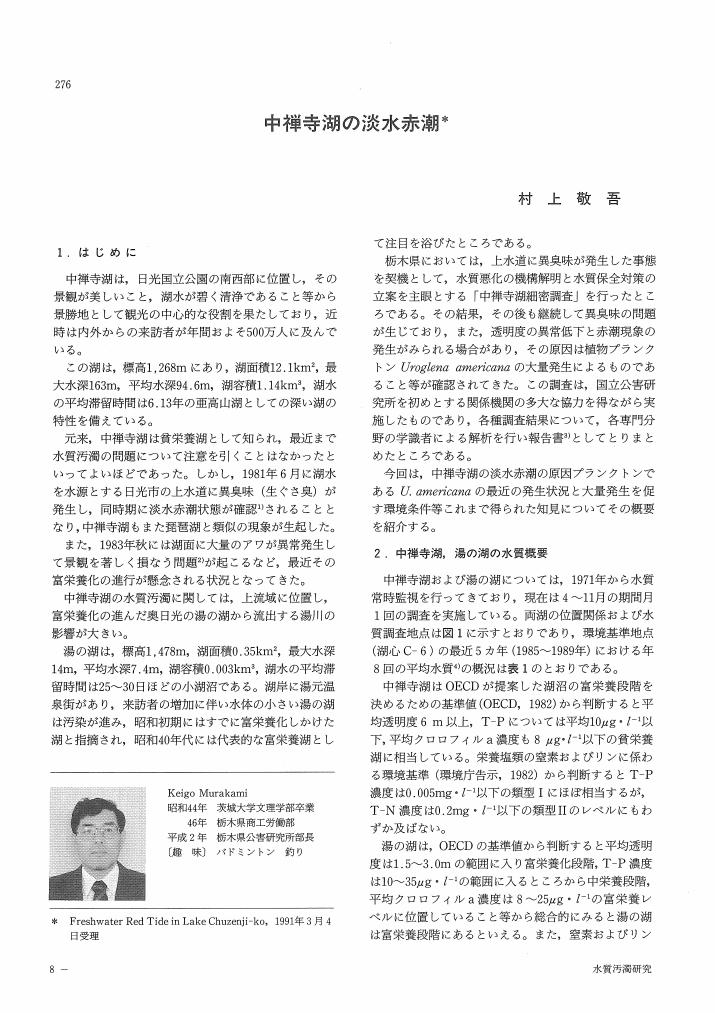2 0 0 0 OA 鉄(III)キレートによるアスコルビン酸の接触酸化
- 著者
- 栗村 芳実 村上 敬吾 土田 英俊
- 出版者
- 公益社団法人 日本化学会
- 雑誌
- 工業化学雑誌 (ISSN:00232734)
- 巻号頁・発行日
- vol.72, no.8, pp.1698-1702, 1969-08-05 (Released:2011-09-02)
- 参考文献数
- 11
- 被引用文献数
- 1
鉄(III)キレート触媒によるアスコルビン酸の酸素酸化反応をpH1.5~5の水溶液中で,酸素吸収速度を測定することによって研究した。鉄(III)イオンのみが存在する場合には,アスコルビン酸の酸素酸化反応の速度は,比較的小さい。しかし,NTA,EDTAOH,EDTA,CyDTAおよびDTPAなどを配位子とする鉄(III)キレート触媒を用いると,アスコルビン酸の酸化は著しく促進される。これらの鉄(III)キレートの触媒活性は,一般に,キレートの性質,溶液のpHなどによって異なる。アスコルビン酸が鉄キレートに比べ大過剰であるときは,酸素吸収速度は,鉄(III)キレートおよび酸素分圧に関して,それぞれ見かけ上一次になる。鉄(III)キレートの触媒活性は,pH3~5において,Fe(III)NTA<Fe(III)EDTAOH>Fe(III)EDTA>Fe(III)CyDTA>Fe・(III)DTPAであった。鉄(III)キレートのアスコルビン酸酸化における触媒活性の大きさの順序は,これらのキレートを触媒としたときのかフェニレンジアミンの酸化的重合反応における,活性の大きさの順序とよく一致し,鉄(III)キレートの安定度定数がほぼ1020で活性極大に達する。得られた実験結果に基づき,鉄(III)キレートによるアスコルビン酸の接触酸化の機構を推定した。アスコルビン酸過剰の場合には,鉄(III)キレートが速い反応でアスコルビン酸を酸化し,その結果生成した鉄(II)キレートが酸素酸化する段階が律速であることが明らかとなった。鉄(II)キレートの酸素酸化の速さが,鉄(III)キレートの触媒活性を支配する主な因子であり,その段階はいくつかの反応経路を持つことがわかった。
2 0 0 0 OA 中禅寺湖の淡水赤潮
- 著者
- 村上 敬吾
- 出版者
- 公益社団法人 日本水環境学会
- 雑誌
- 水質汚濁研究 (ISSN:03872025)
- 巻号頁・発行日
- vol.14, no.5, pp.276-280, 1991-05-10 (Released:2009-09-10)
- 参考文献数
- 9
1 0 0 0 OA 中禅寺湖流域における陸水の水質形成について
- 著者
- 村上 敬吾 笹沼 治雄 小山 次朗 小林 紀男 平山 光衛
- 出版者
- 日本陸水学会
- 雑誌
- 陸水学雑誌 (ISSN:00215104)
- 巻号頁・発行日
- vol.48, no.4, pp.295-306, 1987-10-30 (Released:2009-11-13)
- 参考文献数
- 27
This study deals with mechanism of water quality formation in rivers and lake waters in the drainage basin of Lake Chuzenji. Water samples were collected at 15 stations in 9 lakes, 14 in 7 rivers and 16 in springs or wells from April 1983 to November 1984 (Figs. 1 and 2). Chemical analyses of the main inorganic constituents dissolved in the water samples collected revealed that surface and underground waters in this region are generally low in dissolved chemical constituents, except for the hot springs on the northern shore of Yunoko (U-3), two springs along Yukawa (U-12, U-13) and Jigokugawa (U-11) (Fig. 4). Most waters belong to Ca·HCO3 type. The water quality of Yunoko is controlled by the qualities of the spring and hot spring waters on the shore of the lake. Jigokugawa (Hell River) has higher concentrations not only in main constituents but also in minor PO4-P and NO3-N than other waters in this region except for the hot spring water. The high concentrations of the main constituents seem to originate from dissolution of volcanic rocks. Table 6 shows that the water quality calculated theoretically from chemical loads which are brought into Lake Chuzenji through rivers and precipitation shows a good agreement with the measured water quality of the lake water except soluble silica. Soluble silica becomes insoluble due to the biological activity of diatom.
